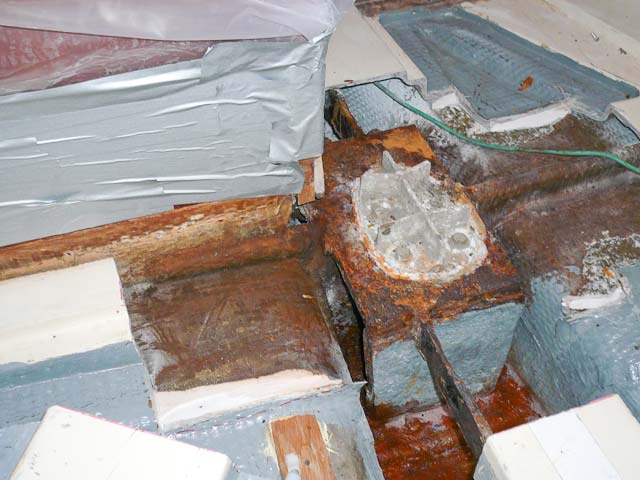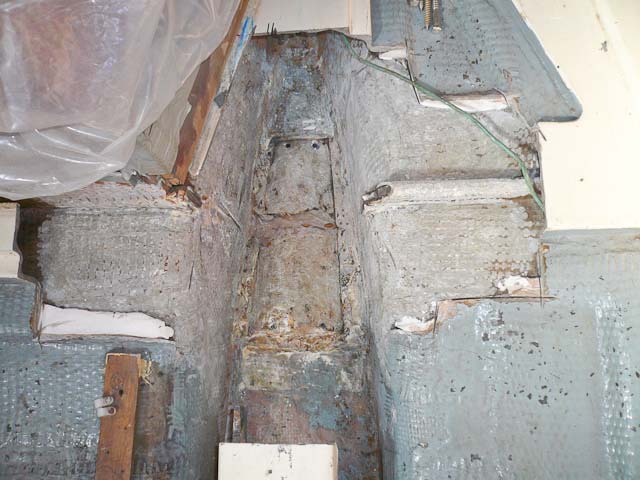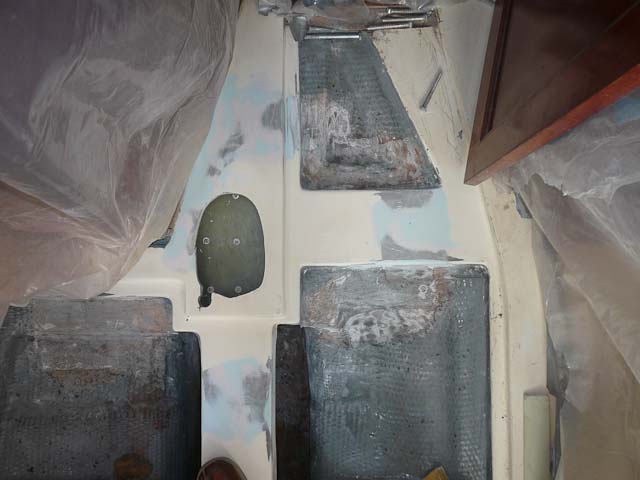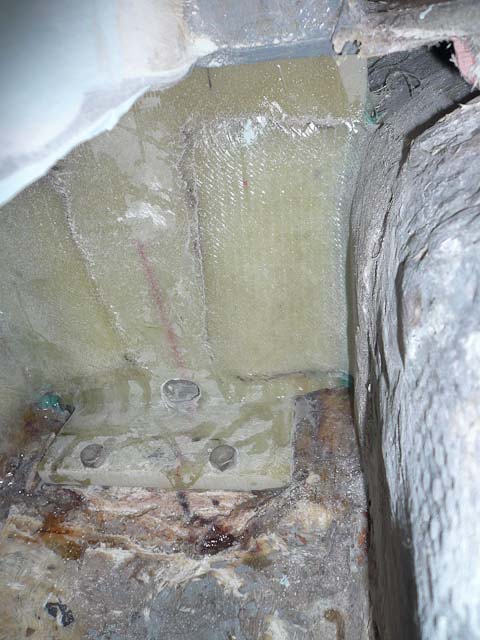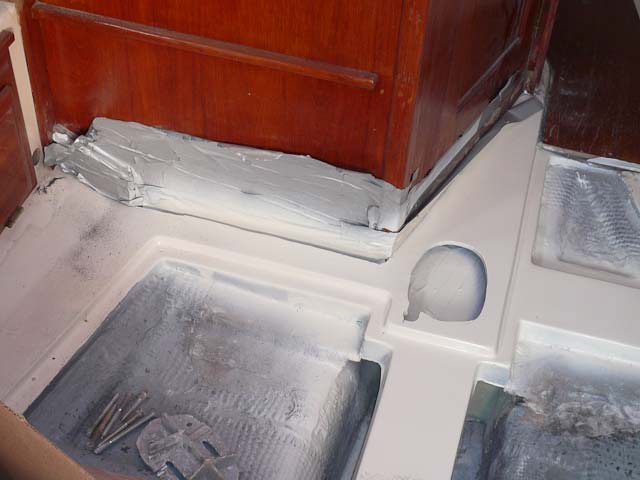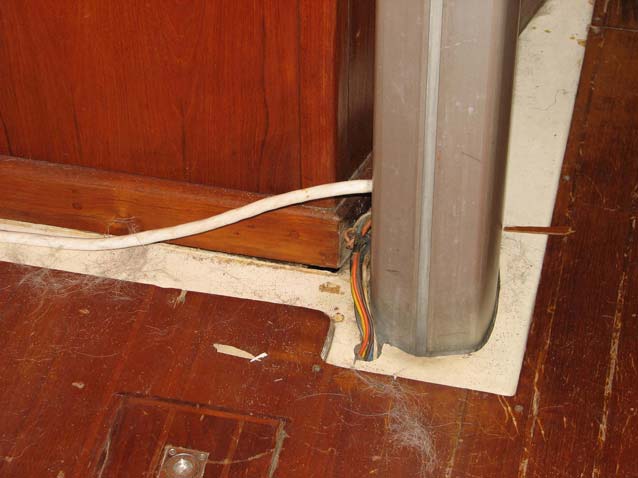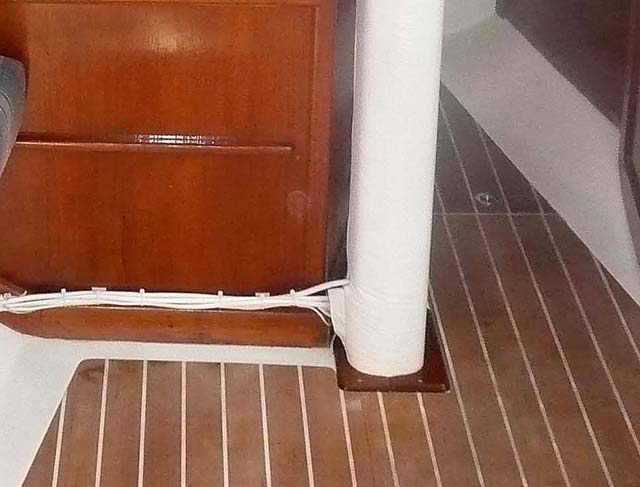Mast Step/Grid (I-Beam) Rusting (E35 to E43)
Date: October 8, 1998
From: Ed Dowd eDowd@Adv-Sys.com
\My 1984 Endeavour 33 has an iron i-beam standing vertically as the support member under the mast step. The top 4 to 5 inches extend above the fibergalss and is showing a fair amount of rust and scale, to the extent that I flaked off pieces of rust approx. 1 in x 1 in x 1/8 in thick with my fingers. The problem was nearly missed and could only be seen clearly by unscrewing and lifting out the sole in the main salon.
My questions are:
Has anyone else had the same problem; and if so, what treatment methods were needed & used. (note: my surveyor told me that while the piece was not yet structurally a problem, that I should prevent further metal loss. He also said that since the E33 was one of the few models designed by Bruce Kelley that this may be a unique problem to just the E33's.) Thanks in advance.
Date: October 8, 1998
From: Dennis & Barbara Rings Moxsun@aol.com
We have a 1980 E43. Our main mast step (it's a ketch) had a lot of rust, too. Our I-beam is perpendicular to the mast with a section up from the fiberglass. (Probably to support the weight of the 60' tall mast). The surveyor said the same thing to us. We are going from Great Lakes sailing to blue water, so we opted to replace the beam.
It was not difficult technically but interesting when you have to weld with your head down and feet up in a small space. We had water hoses and fire extinguishers handy. We're glad we did it. I don't want to lose a mast at sea.
I agree with you, it's an easy thing to miss. Let us know if you have any particular questions.
Date: October 8, 1998
From: Don Freeman DNFSirius@aol.com
E-43 have the same problem and similar construction. Large flakes may not necessarily mean the same thickness of metal has been lost. If only minor, then grinding, chiseling, etc. to get to near bare metal and then multiple coats of metal rust prep, followed by multiple coats of epoxy paint. We've had no further rust in 4 years with this treatment. Under the mast step there was a void into which water from the chain locker draining eventually reached. This area was filled with epoxy, slow cure, to eliminate the pond from acting on the metal. Of course, the E-43 permits reaching the area. Else, best to remove the step and start over.
Date: October 9, 1998
From: Bob Stocker StockerRA@aol.com
Ed, the E35 has the same setup. What I did was scrap as much as possible down to the bare metal, then got some primer from a metal fabricating shop. Spread that on, making a spray from a paint kit you can get at an auto parts store. It's a little glass bottle with a canister that screws in the top after you put the paint in. Carefully protecting all the wood around the area, I sparyed liberally. Three years later and I still see no signs of additional rust.
Date: October 9, 1998
From: Tom Gilbert TGil95746@aol.com
Wow, My E32 has a chromed compression post on the interior of the cabin, from keel to cabin top. I am amazed that anything else would be used, but then....... Well, good luck. Tom.
Date: October 9, 1998
From: Paul Uhl endvr32@endeavourowners.com
Tom, I believe that what everyone is talking about is an I-beam that runs under the flooring that supports a keel stepped mast. The chrome compression post supports the mast and the coach roof. The E32 doesn't appear to have the I-beam and has the compression post stepped on the internal keel.
Date: October 11, 1998
From: Steve Glick BOATSRI@cyberzone.net
Hi Ed,
Just in case you did not receive my email--I discovered ,upon lifting the cabin sole, that the entire grid had been severely corroded. I determined, however, after scraping and brushing, that there was sufficient metal remaining that rust-proofing was the quick fix for the immediate future. I have not inspected the grid since, but will do so over the winter and let you know the results.
Date: October 17, 1999
From: Bob McManis BMCMANIS@email.msn.com
I had the problem you describe with my mast base so rusted that I was afraid it would collapse so I had the mast base cut out and replaced with a galvanized metal mast base. Work was done by John Callewar at Eastport Spar & Rigging in Annapolis MD. I am convinced that the cause of the rusting was plugging of bilge drain ports passing under the mast base and a small leak forward that caused a fair amount of water to flow aft.
Date: October 3, 2000
From: Don Chisholm d.chisholm@fgh.com
I am about to start on the next adventure in the continuing saga of refitting my 1980 E43. The mast step is so badly deteriorated that I am hauling the stick this week-end in preparation of replacing the step. As I will have to cut out the old step I'm looking for any info as how to gain access to it, what floor-boards will I have to remove, cutting away of the bonding glass and ideas as to what material would be best used as a replacement. Any advise would be appreciated.
Date: October 3, 2000
From: Buzz Segura LAMTBUZZ@aol.com
Hi Don
Thought I would add my two cents ! I dont envy your endeavour to replace mast step. In the process of working on my 1979 E-43 fuel and water tanks, got aquatinted with MY mast step. Badly rusted, found the little "uprights" that position it eaten up a bit.
On the 1989 modle, from what I can see......you would just about have to distroy the boat to remove/replace it (just my openion) The whole kit and kaboodle resides under the forward bulkhead. Couple feet into the salon is section that you can remove to access the mast step & tanks.
I had a hellova time just to wire brush the rust off, treat the metal and apply two coats of epoys to all metal there. Sorry could be of no further help, looke like it would rate a good #8 on the "Futility Index" Good luch my friend
Date: November 10, 2000
From: Curt Toler HTOLER@aol.com
While removing my mast (which had corroded at the base and step) I found that the iron "I-beam" has mostley corroded around the mast-step area, with extensive corrosion under the cabin sole also. My question: Does anyone know the "structual intent" of this iron "I_beam"? And, more importantly has anyone had to deal with this problem? Please let me know your solution(s) so I can address the problem while I've got the cabin sole torn off. Thanks.
Date: November 11, 2000
From: Bob McManis BMCMANIS@msn.com
Curt,
I have a 1984 E-33 and had the very same problem with extensive corrosion of the mast base. In 1997 I worked with John Callewaert at Eastport Spar & Rigging in Annapolis (Phone: 1-800-660-3457). John cut out the original base and fabricated a new one which was welded in to the I-beam structure. The old base was regular structural steel and therefore very susceptible to corrosion in the bilge. I also had a leak forward which drained thru the mast base drain holes. When these got plugged up over time the water was prevented from getting to the bilge and sped up the rusting of the base. John Callewaert made a wooden model of the mast base from which the steel one was made and I believe he kept it. The new base was galvanized and I have had no corrosion problems with it in these past 4 years. John is a rigging expert and a totally knowledgable sailor and I would go back to him for any tough rigging problem. I hope this helps. Let me know how you make out.
Date: November 11, 2000
From: Carol & Bruce McMahon mghtym@aol.com
Curt,
I'm sorry to hear about your I-beam problem. My 1984 E33 was launched in June of this year after a year and a half on land when I purchased her. I'm going to have to ask the ship yard if they noticed any damage when they stepped the mast. I don't know if the surveyor got into her that deeply but will find out. I'll try and find out more about your (and possibly my) problem. Hopefully this is not endemic.
Date: May 29, 2001
From: Robert L. Leto rleto@arl.army.mil
I am interested in purchasing an E43, (but) the mast compression post under the cabin floor needed replacement. Has anyone had this problem and does the cabin floor need to be removed for repair? I appreciate your time in responding to my concerns.
Date: June 1, 2001
From: Stuart Phillips StuP@aol.com
To replace the I beam you have to take out the mast and the cabin sole (floor). It comes out easily and it is modular. You have to take it out to inspect the water and fuel tanks also. If the rest is so bad then you'll have to replace the I beam. I had mine made by a machine shop out of stainless-steel however I think that is overkill and that actually galvanize 1 would last 20 years. If you have any other questions drop me a note.
Date: June 3, 2001
From: ART YACHTS
Our service yard found corrosion in the steel support structure of the mast step on a customer's Endeavour 35. Realizing that a complete and proper repair would be very expensive, with the owner's approval we formed a dam in the bilge forward and aft of the mast step and poured concrete into the space below the mast step, being certain to fill the entire space.
The cured concrete is locked into position by having flowed around the structure, and it fits snugly into the void, thus transmitting all loads from the mast directly to the hull structure. So far, a very satisfactory and inexpensive solution.
West Harbor Yacht Service
New Rochelle NY
Date: June 4, 2001
From: Paul Uhl endvr32@endeavourowners.com
Just a thought,
I wonder if a rust inhibiting paint might work if it's not too far gone? I'm surprised it wasn't encapsulated.
Date: January 7, 2002
From: Russ Smith skybound01@earthlink.net
Hi Paul
I've got an Endeavour 35 that I bought a couple of months ago....as an investment mostly....on my way to an Endeavour 40 to 43. We spent much time, money and effort restoring the boat (it had been neglected for some time), but it looks great now......evidently there has been some water inside the boat and now (discovered in a pre-sale survey) the mast step is corroded away, have I mentioned this before?....almost to nothing. We have been getting estimates for the repair.....at around 6K to 7K. Turns out the stringers that support the step longtitudionally and laterally are also made of iron and are also badly corroded.....in order to replace the stringers most of the interior teak walls and cabin sole will have to be removed, hence the high cost. I've heard of another 35 in the Sarasota area that had the same problem and about the same repair bill.....so I assume that this is a common problem with the 35. The repair yard is planning on replacing the step with aluminum.
I only mention this so that other Endeavours owners can be aware....of course, they probably already are.
![]()
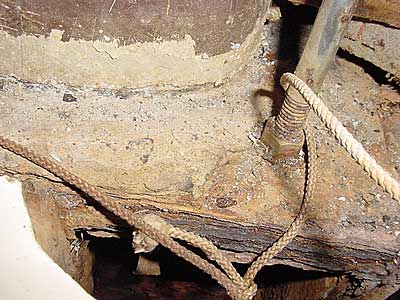
Date: January 13, 2002
From: Phil Cousineau pcousine@tampabay.rr.com
We just replaced ours as well, a 1984 E35, ours looked pretty much like the one in the photo. The surveyor who came on board stepped below and the first words out of his mouth were "let's check the achilles heel", he said it's highly common of the Endeavours. So we removed the stick, had to cutout a small section of the floor, totally cutout the rusted section and had a custom made fiberglass step made, huge. Then we rebuilt and matched the floor cut. It came out great you would never know from looking at the floor.
Cost was around 5,000.00 ugh.
Date: January 13, 2002
From: William Fuller watrbnd@earthlink.net
Guys/Gals-
I too have the problem of a badly corroded mast step on my E-35. I realize it must be repaired before any serious loads are transferred to it from the mast/rigging. My question is this: How far down into the glass must one probe in order to locate the bottom of the step? It appears to be bonded/glassed in place and welded to the athwartship grid. (?) Any comments/information will be most appreciated. Thanx.
Date: March 2, 2002
From: Kim Thorn boatskipper@hotmail.com
Just did mine in a 1982 E43. Without lifting the floor, we cut out the old step and ground down to hull. Refabricated a new plate out of 316 SS. Then glassed it in place and remounted the step on it in it's original position. Relatively painless. Custom SS $450.00 and about 4 days start to factory fresh finish. However it takes abit of craftsmanship and experience with the materials. Any peticular q's dont hesitate to respond.
Date: May 6, 2002
From: Jim Neihoff annaca7@earthlink.net
I have a 1983 E35 hull # 11, Island Dreamer. When shopping for my boat I too found all the Endevours I looked at badly corroded at the step. My boat must have been addressed in the past as the mast is now steped directly to the keel and is encapsulated in an epoxy looking resin. No way to corrode but I hope I never have to remove the mast.
Date: February 11, 2003
From: Russ and Judy Smith flightlevel003@earthlink.net
Hi Paul
I wrote a short note about the mast step on my Endeavour 35 dated Jan. 7, 2002....including a photo of the old mast step....that needs a follow up.
The repair work was completed in Aug. of 2002, at a cost of 5K at Ross Marine in Clearwater, FL. Ross Marine completely cut out the old metal mast step and rebuilt it entirely out of fiberglass.
Also, I have a new e-mail address....flightlevel00@earthlink.net....which is the name of our now completely restored boat. More later,
Date: February 20, 2003
From: Jonathan Richards Endeav35@aol.com
I don't know whether you've read anything I've written regarding this problem. My last boat was a E35 with the same problem. This is also a problem that plagues other boats. My yard was the former finish yard for a high quality Dutch boat of the '70s on which this problem has developed. The yard often services owners of this vessel, and keeps track of every one they built.
In any event the fix they devised while not on its face the not the most appealing or "nautical" seems to work just fine. The fix is to clean out the area, build a dam (and imbed a pipe chase for wiring) on both sides of the I-beam where it sits over the glassed in SS stringer that runs athwartships. They then pour in a concrete that will conforms to the hull and creates a solid load distributing plug that provides a solid and stable support for the mast step. The other advantage of this fix is that you don't need to spend a small fortune removing and rebuilding the head. I was skeptical at first, but in the end with a new mast step sitting on it looked great, I was impressed and it held up to five more years of hard sailing and will likely last longer then the boat.
The yard manager who devised this fix is a successful racing skipper who tunes my boat competitively for better cruising performance. By the way he found that preloading the back stay inducing a slight bend at the top of the mast flattens the main and markedly improves performance. In any event even with this kind of loading the step stayed as solid as a the rock it became. I now own an E38.
If you want more information I can put you in touch with the yard which is located in New Rochelle, NY (western Long Island Sound) and is a sail only yard, no power boats please.
Date: December 6, 2009
From: Kurt Zabriskie KURTZABRISKIE@aol.com
Would you tell me if it is hard to replace the Steel base of the mast step (on my E33)?
Date: December 7, 2009
From: Tim Shanahan tim@compasssecurities.com
Spirit's mast step is definitely rusting in big flakes. I've tried to but a little time by wire brushing and spray painting with a Rustoleum paint but at some point it will require a bigger solution. I've had Spirit for 4 years an never pulled the mast but plan to this spring to re-wire some lights and instruments.
Date: December 7, 2009
From: Gerhard Scherer gms-transfer@web.de
Hello Paul, Hello Kurt
I've had the mast step replaced last December by my yard and everything documented with pictures. I am very willing to share my experiences.
All metal used by Endeavour yacht for the mast step and the bars attached to it were not made of stainless steel. This led to serious corrosion and damaged the mast step over time. I've decided to let my yard do the messy job and ended up with a nice solution based on G10 material.
The Endeavour was built like a tank and it took a while to take out the old mast step. The horizontal steel beams where also effected and I let the yard to decide how much they would like to replace.
Please take a look at the pictures I've attached to this email.
The yard spent about one week and I used this and additional time to completely rewire the mast.
Because I don't like to run cables/wires in and through the bilge area other than the bilge pump, I have also changed the path of the all cables. (Please note that the cables are not yet covered with a nice sleeve and the cabin sole is still raw and not painted - the boat is not finished yet)
I ended up with a $5k price tag for the mast step.
Date: December 7, 2009
From: Bob Mcmanis bmcmanis@comcast.net
Paul & Kurt,
I had the mast base replaced on my 1984 E33 over the winter of 1998 after I discovered that it was rusting badly. The work was performed by Eastport Spar & Rigging, in Annapolis,MD. (phone: 800-660-3457). John Callewaert managed the job and is an expert on sailboat rigging. I have been very pleased with the job.
The basic cause of the problem was that the mast base was constructed of mild steel and is located in the bilge where it is exposed to a very corrosive bilge water environment. My problem was magnified by the fact that I had/have a small leak on the main deck forward which caused a trickle of water past the mast base into the bilge whenever it rained or took water over the bow. I have not been able to find and correct the leak and it undoubtedly hastened the rusting of the mild steel mast base.
In short the job included: removal of the mast, removal of mast base socket; removal of fiberglass surrounding the mast base; cutting out of the mild steel mast base; clean-up of bilge glass work; grind surfaces and prep for reinstallation; measuring, templating and design of the new mast base; fabricate, weld and galvanize new support structure; reinstall and weld support in place (the mast base is an integral part of the boats metal grid structure); replace floorboard support fiber glass structure around the mast; reinstall mast base socket; reinstall mast, including Spartite kit for mast/deckhouse penetration.
The total cost back then (1998) was $8216.69, a bit higher than the original estimate of $7254.62. This cost also included rewiring the mast, replacing all running rigging and other incidental work on the mast and rigging. I have not noticed any deterioration of the galvanized base over the past 11 years even though the leak persists and water is present much of the time. I'd be happy to answer any specific questions and I am sure John Callewaert would be glad to take on the job. He planned to keep for possible future use the mast base template which was made of plywood.
![]()
